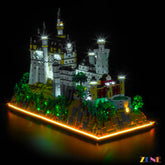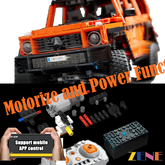Building LEGO Technic cars with Power Functions isn't just about following instructions—it's about understanding the engineering principles that make real vehicles work. Mastering these fundamental automotive systems enhances both your LEGO building experience and your understanding of real-world engineering principles.
In LEGO Technic builds, your chassis typically consists of interconnected beams, pins, and axles that create a rigid yet flexible platform. When designing your LEGO chassis, consider the wheelbase (distance between front and rear axles) and track width (distance between left and right wheels).
Powertrain
1. Clutch
Clutch Function in LEGO AWD Systems
The clutch mechanism in this LEGO build serves as a simple on/off switch that controls the power distribution between front and rear axles. In the default "off" position, both differentials rotate together through a direct main driveshaft connection, creating standard all-wheel drive with equal front and rear speeds.
Some PF system includes a slipper clutch component that prevents damage from excessive torque loads. This allows the mechanism to slip under high stress rather than binding or breaking gear teeth, protecting the entire drivetrain during aggressive operation.
2. Gearbox
A gearbox uses combinations of gears with different tooth counts to modify the relationship between input speed and output torque.
In LEGO terminology, you'll work with various gear elements including spur gears, bevel gears, worm gears, and differential gears. Each serves specific purposes in your drivetrain. Spur gears, the most common type, transfer power between parallel shafts and come in different tooth counts (8T, 12T, 16T, 20T, 24T, and 40T in standard LEGO sets).
Gearbox Working Principles
While LEGO's typical approach treats "gearboxes" as simple power splitters for distributing single PF motor output to multiple functions, true multi-ratio gearboxes unlock significant performance potential. They enable vehicles to have both low-speed torque for climbing obstacles and high-speed capability for racing, mimicking real automotive transmissions. Like 7+R (7 forward + Reverse) gearbox operates through a layered gear selection system. Power enters through coupled driving rings, allowing input from multiple sources.
The 4-speed variant for 4WD vehicles incorporates a central differential at the output, distributing power evenly between front and rear axles while allowing speed differences during cornering. The central differential prevents drivetrain binding that would occur if front and rear axles were rigidly connected.
3. Drivetrain Layouts

Front Engine, Front-Wheel Drive

Front Engine, Rear-Wheel Drive

AWD - All-Wheel Drive
| Type |
Driven Wheels |
Key LEGO Challenges |
Best For |
| FF (Front-Wheel Drive) |
Front wheels |
Steering interference with drive |
Compact cars, simple builds |
| FR (Rear-Wheel Drive) |
Rear wheels |
Driveshaft space management |
Sports cars, drift models |
| AWD (All-Wheel Drive) |
All four wheels |
Central diff + suspension geometry |
Off-road, high-performance |
4. Differential Systems
The differential solve the fundamental problem that wheels on opposite sides of a vehicle must rotate at different speeds when cornering. Without a differential, the inside wheel would either scrub against the ground or the outside wheel would lose traction.

Differential
A differential is a mechanical device that allows two wheels on the same axle to rotate at different speeds while receiving power from a single input. During turns, the planetary gears rotate on their axes, allowing the outer wheel to rotate faster than the inner wheel while maintaining power to both.

How Differentials Work
The differential uses a set of planetary gears housed within a ring gear. When driving straight, both wheels rotate at the same speed. During turns, the planetary gears rotate on their axes, allowing speed differences between the output shafts while maintaining power to both wheels.
Differential Limitations: The Off-Road Problem
If one wheel loses traction (lifted off ground or on slippery surface), an open differential will send all power to the spinning wheel while the wheel with traction receives no power. This explains why crawlers and off-road vehicles often need differential locks.
Differential Lock Solutions
The introduction of new gears from the Ferrari Daytona set offers fresh possibilities for creating custom differential locks and modified drivetrain configurations, particularly valuable for off-road LEGO builds where traction control is more important than smooth cornering.
Many off-road LEGO builders prefer locked axles over open differentials, prioritizing climbing ability and traction. Shop Now
Chassis
1. Universal joint
A universal joint (U-joint) is a flexible coupling that transmits rotational motion between two shafts at an angle, allowing power transfer even when the axles aren't perfectly aligned.
U-joints: Transferring Power Around Corners
In LEGO Technic, universal joints (U-joints ) appear as specialized connector pieces that link axles at various angles. They consist of a cross-shaped center piece (the spider) connected to two yokes, allowing rotation to transfer smoothly even when the input and output shafts meet at an angle. This flexibility is essential in front-wheel-drive LEGO vehicles where the drive axles must accommodate both steering movement and suspension travel. Shop Now
In LEGO Power Functions or Technic systems, U-joints (often plastic CV joints or biscuit joints) enable drivetrains to handle suspension movement or steering angles while maintaining power delivery. They’re crucial for AWD setups, independent suspension, and steering linkages—preventing binding and ensuring smooth rotation. Newer LEGO sets use compact double-ended CV joints (like 4L/5L variants) for tighter spaces or advanced features like drifting mechanics. Their modular design balances strength and flexibility in motorized builds.
2. Independent & Solid Axle Suspension
Independent suspension excels in performance, while solid axles suit heavy-duty or simplified builds.

Independent Suspension
Each wheel moves independently, connected via wishbones (A-arms) or trailing arms with shock absorbers. Power is transmitted through CV joints/U-joints to maintain drivetrain flexibility. Found in high-end 42154 Ford GT sets for better articulation, and AWD compatibility.

Solid Axle (Live Axle) Suspension
Wheels are linked rigidly (e.g., beam axle), moving together. Simpler but less adaptable to uneven terrain. Live Axle Suspension Common in older/truck 8070 Supercar sets for durability and ease of construction.

Bearing Drive Axle Metal Alloy (1:10)
For high-performance speed RC modification. The RC drive axle is suitable for 1:10 models. It uses high-strength 3D printed plastic parts and alloy brake discs to be equipped with separate RC tires, which are not compatible with Lego tires.
Shop Now

Bearing Drive Axle (1:8 Ferrari wheel)
For high-performance speed RC modification. The RC drive axle is suitable for 1:8 models. It uses high-strength 3D printed plastic parts can be well compatible with Lego wheels and tires, as well as transmission solution.
Shop Now
3. LEGO Shock Absorbers
LEGO shock absorbers (e.g., hard/soft/medium springs) provide damping and stability to suspension systems by absorbing impacts and maintaining wheel contact with the ground. Often paired with wishbones or trailing arms to manage wheel articulation. They allow controlled compression/rebound, improving handling on uneven surfaces.
Types: Hard (stiff, for stability), Soft (smoother travel), Medium (balanced).
Engine
Gear Pump Simulation
Gear Pump Simulation demonstrates how two meshing gears create volumetric displacement within an enclosed chamber. Using LEGO Gear Wheels and Axles, AFOLs(Understanding What AFOL Is) can construct a mechanical representation of this hydraulic principle.
LEGO Technic Gear Pump Simulation
When the gears rotate, fluid (conceptually) gets trapped between gear teeth and the housing, then carried from the inlet side to the outlet side. The meshing point prevents backflow, while the gear teeth act as moving pistons that displace volume.
While LEGO cannot handle actual fluids, the mechanical motion clearly illustrates how gear pumps function in automotive power steering, lubrication systems, and hydraulic circuits. Learn Pneumatic Power
Steering
Steering System Simulations

Recirculating Ball Steering Simulation
The worm gear(#4716) represents the steering input shaft, while the larger gear(24-tooth or 36-tooth) acts as the "nut" that would normally contain recirculating ball bearings. As the worm gear rotates, it drives the larger gear, which connects to steering linkages. This creates high mechanical advantage and self-locking properties—the steering wheel can turn the wheels.

Rack-and-Pinion Steering System
When the steering wheel turns, the pinion gear((8T or 12T)) rotates and moves the rack(Horizontal toothed bar that meshes with the pinion) laterally. This linear motion transfers through tie rods to pivot the front wheels. The linear rack movement connects to steering arms via connecting rods, creating realistic Ackermann geometry for proper cornering behavior.
Braking
In automotive builds, parking brakes typically use friction-based mechanisms with rubber rings or mechanical linkages to lock drivetrain components, preventing vehicle roll when parked.

Parking Brake Systems
The LEGO Technic airplane utilizes a pneumatic parking brake system that applies compressed air pressure to wheel brake assemblies. This system provides high clamping force necessary for aircraft ground operations, preventing movement during engine run-ups or parking.

Disc Brake Systems
Power Functions sets like the Ferrari Daytona SP3 (42143) feature working disc brakes on all four wheels, taking advantage of new wheel designs that provide space for brake assemblies around the hub. The 5-spoke wheel design exposes the brake mechanism, creating visual authenticity.
Advanced MOC Solution
Electronic Parking Brake
The servo motor drives a cam or linkage system that applies friction elements to the drivetrain. Bluetooth connectivity allows remote activation through smartphone apps, while programmed logic can include automatic engagement when the vehicle stops or safety interlocks.
ZENE Bricks advanced system provides realistic electronic parking brake functionality found in modern vehicles, making it ideal for high-end MOC builds requiring authentic automotive features.
Conclusion
Mastering these fundamental automotive systems enhances both your LEGO building experience and your understanding of real-world engineering principles. Each component—from the elegant simplicity of universal joints to the complex interactions within differentials—contributes to creating vehicles that not only look impressive but perform with realistic behavior.
Remember that the best LEGO Enthusiasts combine creativity with engineering knowledge, using these mechanical principles as tools to bring their automotive visions to life.





































Leave a comment
Please note, comments need to be approved before they are published.